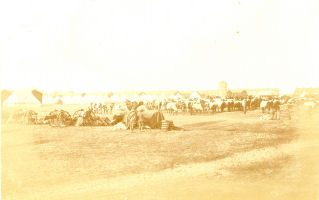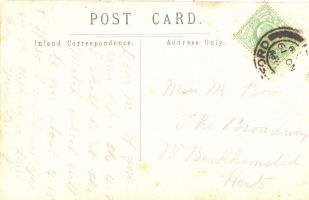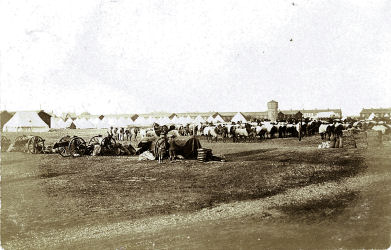|
Mystery Military Photograph, posted at Watford, 1909
now James Humphries, Watford, WW1 November, 2011 |
|
||||||
|
Mystery Military Photograph, posted at Watford, 1909
now James Humphries, Watford, WW1 November, 2011 |
|
||||||

I recently saw a very faded post card for sales on ebay which appeared to show an army camp and which was said to have been posted in Watford. My initial reaction was that it was another photograph of the camps that were established in Hertfordshire at the start of the First World War. I decided it would make a useful challenge to see what I could find out more about it and brought it for £1.99. The result is a good example of how it is sometimes possible to extract a story from the most unpromising of cards.
 |
 |
|
| What came through the post looked very unpromising at a quick glance. The picture of the troops was as expected from the advert, and the back (which hadn't been shown in the advert) was in very faded pencil. Even the frank referred to in the advert was not as clear as it might have been. | ||
What the Picture shows
 |
The first stage was to digitise the picture and process it using Corel Paint Shop in order to capture the very faint details along the sky line. This made it clear that there was no sky detail, no distant objects visible outside the camp area and nothing significant in the foreground. A high resolution strip scan, with corrections, was carried out and can be seen below (click on picture for greater detail). |
|
What the Address side shows
|
|
|
|
While the frank is incomplete, the stamp is a halfpenny stamp of Edward VII, and it is reasonable to assume that the card was posted in Watford on the afternoon of Friday, November 19th, 1909, and would have been delivered to Miss Rowe on the Saturday Morning. |
||
|
While the card is almost unreadable by eye it is possible to augment the digital image to a point where the writing is very clear. We are given the name and address of "M" and the card was sent by "J." So what further can be deduced from the written message.
|
The Card was posted to Miss M. Rowe The Broadway Nr. Berkhamsted Herts |
|
|
Dear M
If you come before the 4.18 I shall be at the Match which will be over about 4.15 & If so I could see you in the High Street or down home.
yours truly J |
|
The Search for Miss M Rowe
The obvious starting point is to try and identify M.
Her location was "Broadway" which on modern maps is represented by Broadway Farm, at the south end of what was then the parish of Northchurch, and part of what is now known as Bourne End. In 1908 James G Knowles & Son were at Broadway Farm, Northchurch, Berkhamsted (Kelly's Directory for Hertfordshire). Unfortunately the census is unhelpful. In 1901 James Goodall Knowles was farmer at Broadway with one live-in domestic servant and two cottages occupied by farm labourers. Ten years later Alfred Knowles was the farmer & miller at Broadway and employed two domestic servants, one only aged 15, so would only have been there a short time. The two cottages were still occupied with farm workers. It seems possible that M Rowe was a domestic servant at Broadway Farm but had left there before the 1911 census. There was no easily identifiable "M Rowe" in the area in the 1911 census and I even checked to see if a "M Rowe" had married or died in the Berkhamsted or Watford registration areas between November 1909 and March 1911 with negative results. HOW FRUSTRATING ... As if I can't track down the right Miss M Rowe any chance of tracking down J by this route would appear to have vanish. But I didn't give up. The Date and Place of the Army Camp What is clear from the date is that it is not connected with the First World War. To get anywhere one needs to make some assumption, and if the assumptions are wrong the conclusion is likely to be wrong. The assumptions are that J attended the army camp shown in the picture from his home in Watford, and that the picture shows a Royal Field Artillery unit of what was then called the Territorial Force on the evidence of the guns seen in the picture. The book The Hertfordshire Batteries Royal Field Artillery reports that on 12th October 1908 the newly formed Hertfordshire Batteries had been established. In particular the 2nd Battery Headquarters were at Watford with drill stations at Hemel Hempstead, Berkhamsted, Tring and Kings Langley. In describing the history of the batteries the book continues:
This immediately suggested that the photograph could be of the Hertfordshire Batteries on their summer 1909 training camp at Lydd. A return to ebay showed that there were a number of cards showing Lydd camp before the First World War, and some actually identified the East Anglian Division (of which the Hertfordshire Batteries were a part). The following shows a view of the camp from the tower of Lydd Church. This post card is an early one, and probably shows the camp in about 1905 - before the Territorial Force was created. It shows 5 pairs of huts when later views show 5 rows of 4 huts, as can be seen in the following details from other pre-First World War post cards.
View showing a large training camp with many bell tents.
Tintown Camp, Lydd. |
|||||||||||||||||||||||||||||||||||||||||||||||||||||||||||||||||||||||||||||||||||||||||||||||||||||||||||||||||||||||||||||||||||||||||||||||||||||||||||||||||||||||||||||||||||||||||||||||
|
Did J marry Miss M Rowe? One possibility is that J married M after the date of the 1911 census - and it is worth looking for possible couple. A search on FreeBMD suggested two possible candidates.
An examination of the 1911 census showed that Florence Rowe and Joseph Budd were neighbours, both lived in Frogmore Street, Tring, and there was no obvious connections with either Berkhamsted and Watford. There seemed no point in following this couple further. The marriage between Margaret Rowe and James Humphries seems far more promising. Margaret Grace Rowe was born in Berkhamsted in early 1891, her parents being Frederick (23, born Pitstone, General Labourer) and Sarah (31). They were living in the house of Margaret's grandfather, John Grover (76, born Berkhamsted) in Highfield Road, Berkhamsted. Ten years later she was with her parents (Frederick was now a bricklayers labourer) at 13 High Street, Berkhamsted. In 1911 she was boarding at 49 Porchester Road, Paddington, London. Her occupation was described as a "mantle hand" and the occupations of the many other boarders in the property suggests this was in the clothing industry, possibly a tailoring sweat shop. James Humphries was born in Rickmansworth in 1888 and in 1901 and 1911 he was living with his uncle Daniel James Atkins (chimney sweep) at 18 Queens Road, Watford. He was a chimney sweep in 1911. There are three things which are attractive about this couple being the M and J of the card. On the card J wrote "If you come before the 4.18 I shall be at the Match which will be over about 4.15 & If so I could see you in the High Street or down home." Now Watford had a successful football club (see The History of Watford Football Club) and if the team was playing at home on 20th November 1909 (could be checked with the Watford Observer) James would have left the ground in Vicarage Road, and walked along part of Watford High Street, to reach home at 18 Queens Road. The second thing relates to James' occupation as a chimney sweep. If you were a member of the Territorial Force you were expected to attend the summer training camp, and your employer was expected to release you for the purpose. The book The Hertfordshire Batteries Royal Field Artillery says "The prospect of a fortnight by the seaside in the summer was, of course, a significant factor in persuading many young men to join the Territorials." The demand for chimney sweeps would have been lowest in July and August - so the possibility of a fortnight's "jolly" away from home in the middle of the summer would have been very attractive for a young chimney sweep. If he had joined shortly after the Battery started to recruit in 1908 he would have been to Shoeburyness in 1908, and Lydd in 1909 and 1910.
Finally the social clues are all right. The daughter of a labourer appears to take a domestic servant job at a local farm - before taking a lowly paid job in London. She marries a chimney sweep who was living a few mile away by road or railway and moves to the Watford area where their first child is born.
|
|||||||||||||||||||||||||||||||||||||||||||||||||||||||||||||||||||||||||||||||||||||||||||||||||||||||||||||||||||||||||||||||||||||||||||||||||||||||||||||||||||||||||||||||||||||||||||||||
|
Was James in the 2nd Hertfordshire Battery in 1909? A good question - but at this point I have run out of information which I can easily access from my computer desk, as the book The Hertfordshire Batteries Royal Field Artillery does not have an index, and does not mention many of the gunners by name (although officers are indentified). However a substantial archive of Hertfordshire Regiment records have been deposited at HALS (Reference D/EYO) and may contain lists of all the officers and men who attended the camp in 1909. This part of the investigation will have to wait. There is another possible source. Many local newspapers published accounts of the summer camps and it is likely that the Watford Observer included details of the 1909 camp, but may not have listed the men in the ranks who attended. The situation could be different the following year. The Hertfordshire Batteries reports on what happened in 1910 in great detail, quoting part of a detailed report from the Watford Observer. During the firing practice at Lydd the 2nd Hertfordshire Battery qualified to compete in the Kings Cup competition for Territorial Field Batteries. This was held at Okehampton, Devon, on 25th August and the Watford based battery won the cup with a firing score of 82½%, compared with the runners up who scored 63½%. The book includes the following photograph of the winning team - which may well include James if my analysis is correct - the original picture being in the Regimental Collection at HALS. The full Watford Observer article may well include a list of all the members of the winning battery. |
|||||||||||||||||||||||||||||||||||||||||||||||||||||||||||||||||||||||||||||||||||||||||||||||||||||||||||||||||||||||||||||||||||||||||||||||||||||||||||||||||||||||||||||||||||||||||||||||
|
|
|||||||||||||||||||||||||||||||||||||||||||||||||||||||||||||||||||||||||||||||||||||||||||||||||||||||||||||||||||||||||||||||||||||||||||||||||||||||||||||||||||||||||||||||||||||||||||||||
|
The 2nd Hertfordshire Battery in 1910. Even if it turns out that James Humphries is not J, it is very likely that J is one of the people in this picture. |
|||||||||||||||||||||||||||||||||||||||||||||||||||||||||||||||||||||||||||||||||||||||||||||||||||||||||||||||||||||||||||||||||||||||||||||||||||||||||||||||||||||||||||||||||||||||||||||||
|
If neither of the above sources produce results it could be worth trying to track James during the First World War. If he was still a member of the Territorial Force in 1914 he probably left Watford by train on 1st August for the annual training camp in Scotland with the rest of the 2nd Hertfordshire Battery. Within 6 hours of arrival they were instructed to return to Hertfordshire and prepare to mobilise to war stations. (The London Gunners come to Town describes what was happening in the area on the first days of the war). If James Humphries turns up as a gunner in the East Anglian Division in 1914 or early 1915 he is almost certainly "our man". Another Card and More Evidence Another card has turned up, in the same handwriting, also addressed to Miss M. Rowe, Broadway, Berkhamsted, Herts, and posted in Watford.
5th Howitzer Battery in Action, Lydd Camp - detail from card posted 6 December 1909
It is clearly the same couple, and it confirms all the conclusions I came to before.
There was also one clue to the couple being affectionate which I had overlooked on the first card - the stamp. In the language of postage stamps a stamp stuck on in this way could be used to send a "secret" kiss or an "I love you." message. Determining James Humphries' Army Career Anthony found information about James' army record on Ancestry and FindMyPast and as a result I was able to find additional information from the information I collected when I wrote The London Gunners come to Town and in J Sainsbury's book The Hertfordshire Batteries Royal Field Artillery - which contains a very detailed account of the movement of James' unit. On the assumption that he stayed with his unit for the whole war period it is possible to draw up the following provisional lifeline.
Anthony added the following comments about the possible existence of his army records
|
|||||||||||||||||||||||||||||||||||||||||||||||||||||||||||||||||||||||||||||||||||||||||||||||||||||||||||||||||||||||||||||||||||||||||||||||||||||||||||||||||||||||||||||||||||||||||||||||
See Military Camps, Hertfordshire Units, 1908-1913 for details of the sports at the RFA camp in Lydd in 1909.
| November 2011 | Page created | |
| April 2012 | Second post card | |
| May 2012 | Military career added | |
| September 2014 | Link to games at Lydd Camp, 1909 | |